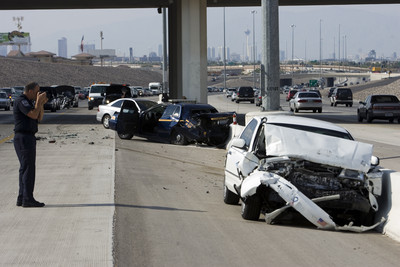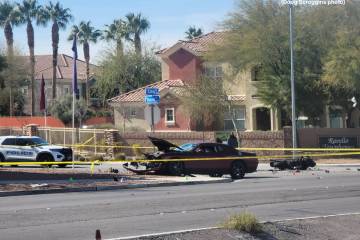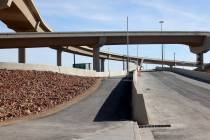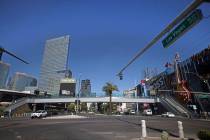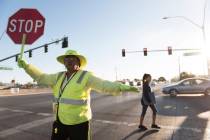Keeping Commuters Alive
Visit the Nevada Department of Transportation's Web site and you'll learn that 188 people have died on our state's highways and byways this year.
This is sobering news; but it's not as bad as years past, considering the average number of deaths in Nevada usually hovers around 400.
Since last year, a number of entities, both public and private -- more than 20 in all, including the Metropolitan Police Department, the Nevada Department of Transportation, and AAA -- have united to come up with ways to keep us, the commuting public, alive.
One of the main goals of the Nevada Strategic Highway Safety Plan is to keep 100 more people alive every year than died the year before in crashes.
Although the plan has not met that goal, there has been progress. In 2007, the first year the Strategic Highway Safety Plan was implemented, traffic-related deaths dropped to 380 in the state. There were 427 and 432 traffic-related deaths in 2005 and 2006 respectively.
And now, nearly two-thirds through 2008, there's been about 40 fewer fatalities than at the same time last year.
"We are going in the right direction," said Susan Martinovich, director of the Transportation Department. "We're looking at two years in a row, keeping our fingers crossed that we'll have a downward trend."
So how has the plan kept people from dying?
Martinovich said it's a combination of enforcement, engineering, education, emergency response and data analysis.
Much of the credit, she said, belongs to law enforcement who helped develop the plan and have brought more focus to reducing fatalities.
Law enforcement has played a key role in reducing drunken driving, citing drivers for not using seat belts, and making crosswalks safer for pedestrians.
Martinovich admitted the economy probably has played a role in the reduction of fatal traffic incidents. The rising cost of gasoline has caused many commuters to slow down or drive less.
The added bonus to fewer fatalities is less congestion, faster commutes and less wasted money, private and public, on crashes. The Texas Transportation Institute estimated the cost of vehicle crashes in Clark County was $2.8 billion in 2005.
More can still be done.
During the 2009 legislative session, the Transportation Department along with a number of state law enforcement agencies will be pushing for two key laws to be passed.
The first is to make seat belt violations a primary offense. Almost 45 percent of all the people who die in traffic fatalities are not wearing seat belts.
According to the National Highway Traffic Safety Administration, seat belts reduce the likelihood of dying in a wreck by 45 percent.
Currently, not wearing a seat belt is a secondary offense, which means that a law enforcement officer cannot pull a driver over for not wearing one. They can only issue a citation for not wearing one if there was another offense committed.
The next law the plan calls for is for automated traffic enforcement, or red light running cameras.
Some states that have implemented such a law have seen a traffic fatalities reduced by 27 percent at intersections.
If passed, I believe both laws will help reduce traffic fatalities.
In the meantime, it is probably unlikely that Nevada will have 100 fewer fatal traffic incidents in 2008 than last year.
But who knows? If these two laws are enacted, along with continued enforcement, better engineering and education, maybe we'll get below 300 in 2009.
That's a worthy goal.
If you have a question, tip or tirade, call Francis McCabe at (702) 387-2904, or send an e-mail to roadwarrior@review journal.com. Include your phone number.
The Nevada Department of Transportation announced the following road closures in connection with the Interstate 15 north widening project:
• Bonanza Road, from F to H streets, near Haycock Petroleum, will be closed to traffic in each direction beginning 9 p.m. Monday through Aug. 23 for bridge removal. Motorists should watch for posted detours.
• The Cheyenne Avenue onramp to southbound I-15 will be closed beginning today through the end of the year for ramp work. Motorists should use alternate routes or look for posted detours. Commuters can access I-15 by following Losee Road south to Lake Mead Boulevard.
The Las Vegas public works department has begun work on $5.4 million improvement project to Durango-Riley Park. The project includes construction of lighted pedestrian walks, lighted and paved driveways and a parking lot. Work will take place Monday through Friday during daytime hours. The project will take about six months to finish. While most work will take place away from roads, there may be some lane restrictions on Durango Drive, from Centennial Parkway to Tropical Parkway.
The transportation department announced that the final phase of the 60-mile U.S. Highway 95 widening project, from south of Railroad Pass to Laughlin, is set to begin Monday. When completed the $46 million, 17.8-mile final project will see constructed a four-lane divided highway on U.S. 95, from 2.5 miles south of Searchlight to state Route 163. Officials believe the widening of the road will reduce the number of fatal wrecks. Truck traffic, which had for years crossed over Hoover Dam, has detoured on U.S. 95 to Laughlin after the terrorist attacks of Sept. 11, 2001. Motorists should watch for lane shifts and reduced speeds in the construction zones.



